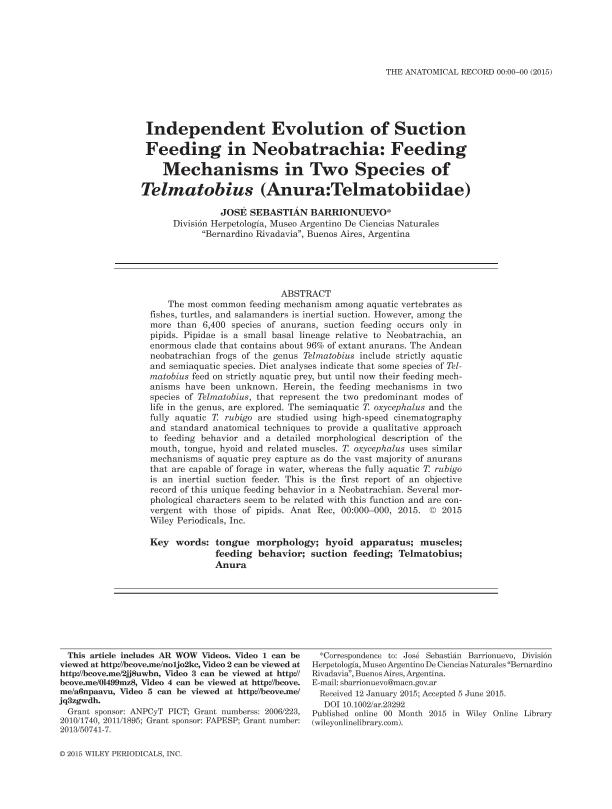Artículo
Independent Evolution of Suction Feeding in Neobatrachia: Feeding Mechanisms in Two Species of Telmatobius (Anura:Telmatobiidae)
Fecha de publicación:
02/2016
Editorial:
Wiley-liss, Div John Wiley & Sons Inc
Revista:
Anatomical Record-Advances in Integrative Anatomy and Evolutionary Biology
ISSN:
1932-8494
e-ISSN:
1932-8486,
Idioma:
Inglés
Tipo de recurso:
Artículo publicado
Clasificación temática:
Resumen
The most common feeding mechanism among aquatic vertebrates as fishes, turtles, and salamanders is inertial suction. However, among the more than 6,400 species of anurans, suction feeding occurs only in pipids. Pipidae is a small basal lineage relative to Neobatrachia, an enormous clade that contains about 96% of extant anurans. The Andean neobatrachian frogs of the genus Telmatobius include strictly aquatic and semiaquatic species. Diet analyses indicate that some species of Telmatobius feed on strictly aquatic prey, but until now their feeding mechanisms have been unknown. Herein, the feeding mechanisms in two species of Telmatobius, that represent the two predominant modes of life in the genus, are explored. The semiaquatic T. oxycephalus and the fully aquatic T. rubigo are studied using high-speed cinematography and standard anatomical techniques to provide a qualitative approach to feeding behavior and a detailed morphological description of the mouth, tongue, hyoid and related muscles. T. oxycephalus uses similar mechanisms of aquatic prey capture as do the vast majority of anurans that are capable of forage in water, whereas the fully aquatic T. rubigo is an inertial suction feeder. This is the first report of an objective record of this unique feeding behavior in a Neobatrachian. Several morphological characters seem to be related with this function and are convergent with those of pipids.
Palabras clave:
Tongue Morphology
,
Hyoid Apparatus
,
Suction Feeding
,
Telmatobius
,
Muscles
,
Anura
Archivos asociados
Licencia
Identificadores
Colecciones
Articulos(MACNBR)
Articulos de MUSEO ARG.DE CS.NAT "BERNARDINO RIVADAVIA"
Articulos de MUSEO ARG.DE CS.NAT "BERNARDINO RIVADAVIA"
Citación
Barrionuevo, Jose Sebastian; Independent Evolution of Suction Feeding in Neobatrachia: Feeding Mechanisms in Two Species of Telmatobius (Anura:Telmatobiidae); Wiley-liss, Div John Wiley & Sons Inc; Anatomical Record-Advances in Integrative Anatomy and Evolutionary Biology; 299; 2; 2-2016; 181-196
Compartir
Altmétricas




